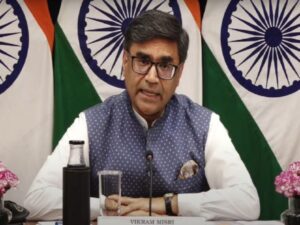Debt sustainability indicators worsen in Pakistan
Islamabad [Pakistan], April 2 (ANI): Pakistan’s major debt sustainability indicators have witnessed marked deterioration during the first half of this fiscal year in the middle of steep currency devaluation and interest rates hikes, revealed a semi-annual debt bulletin of the finance ministry, The Tribune reported.
The July-December 2022 report showed that the share of external public debt rose in the past six months, while the average time of maturity and period of resetting the interest rates have further shortened. This is synchronous with interest rates at historic highs and the currency devaluing by 56 per cent since the incumbent government came into power a year ago, The Tribune reported.
The report showed that the share of external debt in the total public debt rose from 37 per cent in June to 37.2 per cent by December, heightening the currency risks simultaneously with the rupee sinking and foreign countries shying away from extending loans.
The debt office publishes a semi-annual debt bulletin containing information about debt stocks, debt operations and the sources of change in the debt stocks on a semi-annual basis, The Tribune reported.
According to the report, “Large external payments in the wake of low foreign exchange reserves can pose liquidity problems and even destabilise the exchange rate which in turn, can increase the burden of external loans measured in local currency.”
Although the government is not inclined towards debt restructuring, worsening indicators coupled with a lack of adequate foreign funding suggest that Pakistan will soon have to embrace this path, The Tribune reported.
According to the debt bulletin, in dollar terms, Pakistan’s total public debt stood at USD 233 billion by December, including USD 86.6 billion in external public debt. The country needs to service 28 per cent of its debt in just one year, which is quite a big chunk and will expose the nation to all types of debt-related risks.
The floating rate domestic debt is now PKR 22.5 trillion or 68 per cent of domestic debt, which is poisonous due to interest rates at a record 20 per cent.
In rupee terms, public debt jumped to PKR 52.7 trillion, an addition of PKR 3.6 trillion during the first half of the fiscal year. The rupee depreciation added PKR 2.3 trillion to public debt in six months, contributing a rise of 63 per cent to the debt during this period. The interest expenses amounted to PKR 2.27 trillion during the first half of the fiscal year, equal to 72 per cent of the surge in public debt during this period, The Tribune reported.
Some of the increases were offset by withdrawing the cash balances with the banks and primary surplus. The finance ministry stated that containing exposure to external debt is important to manage the exchange rate risk. “The depreciation of the rupee over the last four years against international currencies has resulted in a higher value of external debt when translated into local currency.”
The report also showed that the average time of maturity of the domestic loan reduced from four years to three and half years in one year. This, too, was riskier and would keep the country dependent on commercial banks out to exploit the situation, The Tribune reported.
“Given the prevailing interest rate environment, the demand for domestic debt remained mostly skewed towards short to medium-term government securities,” said the report.
The average time of maturity of the external debt also dipped from an already low level of six years and seven months to just six years and three months. It is even lower than the minimum threshold, causing refinancing risks that have kept the country at the mercy of foreign creditors.
Finance Minister Ishaq Dar said on Friday that the country should learn to live with or without the IMF, a remark that has created confusion about the government’s intentions towards reviving the derailed USD 6.5 billion bailout package.
The finance ministry said that due to the short tenure of foreign commercial bank loans and deposits from friendly countries, there was a reduction in the average time-to-maturity of external debt, The Tribune reported.
The Average Time to Refix (ATR) domestic debt was also reduced to one year and seven months at the end of December 2022 as compared to one year and nine months a year earlier, according to the report. This reduction in ATR was due to a strong market appetite for floating rate debt instruments owing to the prevailing interest rate environment, it added.
A drop in the ATR means that the finance ministry has to rest the interest rate for the debt stock, which makes the government vulnerable to interest rate hikes.
Besides, the ATR of external debt also shrank to five years and three months by end-December 2022 from five years and seven months a year ago due to higher proportions of floating rate external debt inflows, running off of the existing fixed rate external debt portfolio; and a higher proportion of fixed rate external debt maturing within short to medium term.
In yet another significant deterioration, the fixed-rate debt reduced from 26 per cent to just 22.6 per cent of the domestic debt, increasing the interest rate risks. This is coming at a time when the central bank is going to significantly raise interest rates.
A total of PKR 17.1 trillion or 52 per cent of government debt is held by commercial banks, now a source of exploitation and, despite exchange rate manipulation, the government seems unable to impose penalties on some of these banks. Roughly, PKR 15 trillion or 28 per cent of the total debt will mature in one year, which has to be refinanced.
This includes a portion of external debt. The share of floating interest rate domestic debt increased from 62 per cent to 68 per cent. Of the PKR 33.1 trillion domestic debt as of December 2022, a sum of PKR 22.6 trillion had been borrowed on floating interest rates, The Tribune reported.
In March, inflation soared to 35.6 per cent and the share of the floating rate debt will also substantially increase the already overflowing cost of debt servicing.
The only positive indicator was the share of Shariah-compliant debt in the government securities which increased from 6.4 per cent to 9.2 per cent in the last calendar year.






